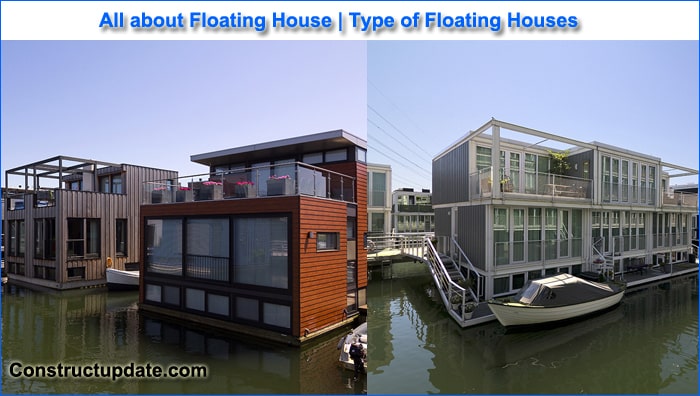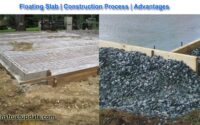What are Floating Houses | Floating Houses Tips | Floating Houses Type | What is Floating Building
Water bodies are calming and tranquil to many individuals. A view of open ocean can be soothing to the spirit. Around the world, some individuals have chosen to leave the land behind and live on the ocean. Houseboats are a bit of a mystery to homeowners, and there are still a lot of unanswered concerns regarding these unconventional residences. Continue reading if you have any pressing inquiries about living in a floating residence.
What Are Floating Houses?
A common example of contemporary technology that has gained a lot of popularity recently is the floating house. Due to the nearly complete coverage of all readily available free spaces, there is not enough available space in the modern world to build a house or any other sort of structure.
You must approach this challenge in new ways in order to solve it. As a result, engineers have developed floating homes as a novel solution to this issue. All the additional components of floating homes are put in after the wooden deck has been built.
Electrical wiring, plumbing, sewer lines, and other infrastructure are permanently connected to floating homes. Engineers use plywood or wooden particles instead of concrete because concrete is too heavy and they want to minimise the overall weight of the project.

What Is a Floating Building?
A floating house is a type of home built on a floating platform that allows the entire building to float above the water. A floating building is a permanent structure that can only be found in one location and cannot be moved.
This kind of building is attached to another permanent structure and cannot be moved. Floating buildings are considered environmentally benign structures since they don’t affect the sea floor or other marine life, and all of their trash is dutifully dumped where it belongs.
Because floating buildings require a more expensive range of raw materials and modern construction techniques, they also require more expensive, high-tech machinery. Additionally, it takes trained labour, which is more expensive, and because the entire system is relatively new to our culture, there is very little demand for it. That is another factor contributing to this building structure’s greater price range.
Floating Architecture Examples
Around the world, there are so many floating structures being built. There are eight landmark floating architectures found throughout the world, and they are as follows:
Drijvend Paviljoen (Floating Pavilion): The Rotterdam Nieuwe River in the Netherlands is where you may find this architecture. Public Domain Architecten and DeltaSync built this architecture. It is built of steel beams, and transparent ETFE sheets are utilised to allow light to pass through both during the day and at night.
The Exbury Egg: This particular type of laboratory, residence, and workplace can be found in Hampshire, England’s Beaulieu River. Fiberglass and cedar woods make up this building.
Wa Sauna: The building in the midst of the lake looks like this. This is situated in Lake Union in Seattle.
Floating Lake Cabin: It was built by MOS architecture and is situated in the lake’s centre. Usually composed of cedar wood, it is a guest home. It is readily accessible from the second floor of the house, and tidal effects are resisted by sophisticated equipment.
Drie Streken: Everyone travels to this floating construction in Northern Netherlands to see the splendour of sunrise and sunset.
Floating Island: Switzerland’s Lake Zurich is home to Floating Island. 30 students from Studio Tom Emerson designed it. There is a swimming pool on the island, and there is a cinema room where you may watch movies.
Archipelago Cinema: This is the theatre that can be found on Thailand’s Kudu Island. It is among the top cinema theatres in the entire world. The entire framework of the building was created by Ole Scheeren.
Type of Floating Houses
1. Permanently Floating House
It is a style of home that floats on the water’s surface continuously. It is a contemporary technology that adds to the expense of construction.
2. House that Floats During Flood
houses that float during floods and land on the ground after the water recedes. Kerala is where you’ll mostly find this style of home.
The side walls of those structures are built of wood and steel, respectively. Here, we use steel pistons to prevent the entire building from flowing. The entire building will rise during a flood.
Principle of a floating house
Based on the buoyancy concept, floating homes don’t need foundations. hence known as buoyant dwellings.
The foundation of the building should be built so that it can support any load that the house may meet, including dead weight, live weight, and other loads.
The dwellings might be built using materials that allow them to float and carry weight, such as hollow pipes, lightweight pads, and boats.
FAQ:
How are floating homes or houseboats powered?
There are several ways to generate electricity on houseboats. Solar power generation is typical for houseboat occupants who are concerned about the environment. It’s a frequent misperception that solar panels work best in places with lots of sunshine. But nothing could be further from the truth. Solar panels don’t actually need the sun to function; they only need light to collect light rather than heat.
Others will make use of a portable 120v AC power generator, which may provide up to 7 days’ worth of power when charged. There will be a charging connector available for you to top off your power generator depending on where you are parked.
On houseboats and floating residences, what happens to the sewage water?
There is no free flush on a houseboat since sewer water is a pollutant. This keeps garbage from contaminating the external water supply. Instead, a built-in cesspit will be available to houseboat occupants. This needs to be properly disposed of at a waste recycling facility. Before embarking on any houseboat excursion, be sure that a tank has been placed; otherwise, you risk not having access to the boat’s facilities.
Do floating homes pay property taxes?
You must pay council tax, just like every other homeowner, if your floating home is in a residential mooring location. You might not experience the same faws if you move about a lot on your houseboat. Houseboats vary depending on where you live, much like motor homes. The residential laws that are in effect in that specific location will apply to you if you have a permanent residence there.
Making a floating home comfortable
If you want to live on a houseboat, it’s crucial to know how to maximise comfort because they can be rather small and uncomfortable. Living below deck, especially for tall individuals, can be uncomfortable and cause neck problems. It’s crucial to spend money on a neck cushion that will enable your neck and spine to recover from hunching over. Additionally, it’s crucial to make sure you have plenty of blankets and comforters on hand because boats don’t retain heat, as well as other types of boats, can.





